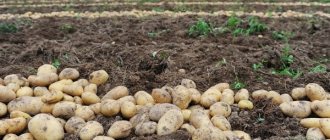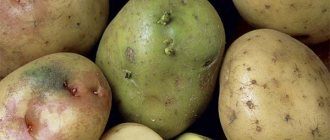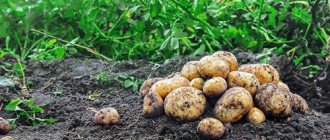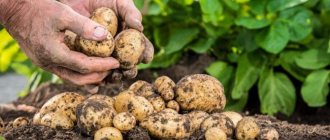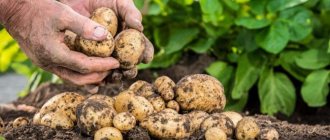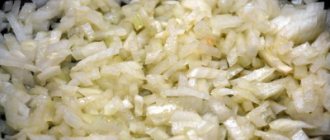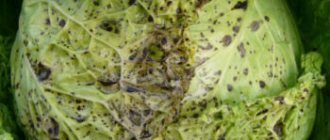Green potatoes indicate that they have been stored incorrectly for a long time. And a significant amount of solanine has accumulated in root vegetables, a substance that poses a danger to human health.
What is the reason for the change in the natural color of the product and whether it remains suitable for human consumption are questions that require careful consideration.
We’ll talk about why potatoes turn green during storage and whether they can be eaten in this article.
Why do potatoes turn green during storage?
The green color in plants is associated with the presence of chloroplast organelles, which contain the green pigment chlorophyll and are involved in photosynthesis:
6CO2 + 6H2O = C6H12O6 + 6O2+E (energy)
This is a unique process on Earth when a plant produces glucose and oxygen from two simple substances: carbon dioxide and water. This releases additional energy necessary for the needs of the cells.
Based on natural characteristics, potatoes turn green in the light. At the same time, the color of the potato skin changes. The varietal color is saturated with a greenish tint. Sometimes green tones shine through the thin skin of the potato. If the potato turns green in the light, then chlorophyll appears in the pulp and the process of photosynthesis is activated. But there is nothing to worry about: chlorophyll itself is a plant pigment and does not affect human health.
But when a potato tuber becomes not just a source of reserve nutrients, but also begins to “work” like a plant, then in addition to chlorophyll, other substances appear in it. And one of them is the plant glycoalkaloid solanine, which is hazardous to health.
After digging up the potatoes, the solanine content in them does not exceed 0.05%. This dosage does not cause poisoning and is safe. In the ground, potato tubers serve as a source of nutrients and do not turn green. But as soon as they get into the light, the situation changes.
Solanine is often produced by plants in the Solanaceae family. For example, there is a lot of alkaloid similar in structure in the leaves and stems of green fruits of tomatoes; it is found in black nightshade and bittersweet nightshade. The aerial parts of potatoes, henbane, belladonna, datura, mandrake, and tobacco are also rich in this compound.
How to prevent potatoes from turning green
What to do to prevent the tubers from turning green? An important point is compliance with storage rules:
- Before storage, sort the root vegetables and remove any green or diseased tubers.
- For winter storage, pallets and shelves are suitable, where the potatoes are covered with protective material so that light does not fall on them. Even electric lighting gives a greening effect.
- If you put a little beet on top, it will prevent the potato tubers from spoiling by absorbing excess moisture. A couple of apples in a box of potatoes will delay the germination of tubers.
- Thermal conditions are important: +2-+4C. With sudden temperature changes, the production of an alkaloid is also possible, although the potatoes do not change color.
- During storage, you need to go down to the cellar 2-3 times and sort through the potatoes, removing rotten and green tubers. But if stored in complete darkness, the tuber will not turn green.
In the basement, to protect from light, potatoes are covered with bags, film, or any opaque covering material that allows air to pass through. This is enough for the tubers to maintain their quality. Is it possible to store potatoes on the balcony? Yes, if it is partially insulated. But storage bags must be opaque. At the same time, air must flow to the tubers, otherwise rotting processes will begin.
Knowing why potatoes turn green, you can avoid this problem: just keep the tubers away from light. When buying root vegetables in a store, you should pay attention to the color of the peel. Perhaps it will turn out to be green around the “eyes” or greenish spots will be visible in places on the surface. Just because potatoes were brought to the store, this does not mean that they are edible.
Sometimes the green color of potatoes with dark skins is not noticeable, since surface pigments mask it. If in doubt, you need to scrape the top part with a knife, and the green color is already clearly visible under the peel.
Precautionary measures
To prevent potatoes from turning green, they should be stored properly after digging them out of the ground. These should be light-proof bags, but in no case rope nets or plastic bags.
If you store potatoes on the balcony, remove them from there immediately. The balcony is very poorly protected from sunlight.
It is better to purchase this product in small portions and store it in the refrigerator in a plastic bag, which will prevent the tubers from withering.
The packaging must not be airtight. Before heat treatment, peel the vegetable, cutting off the skin in a thick layer, as solanine accumulates in it. Green potatoes should be thrown away immediately.
What substance is formed in green potatoes?
Green potatoes are rich in an alkaloid called solanine, which is formed as a result of metabolic processes and most often - in light. In nature, everything is thought out and the synthesis of such a compound is not accidental. It is associated with a protective mechanism that protects potatoes from fungi, insects, various microorganisms, and herbivores.
The alkaloid solanine is abundant in those parts of the plant that are at risk of being eaten. Why do potatoes turn green? When tubers are pulled out of the ground, they are exposed to different conditions and experience stress. In the light, chlorophyll is produced, and then solanine. Biosynthesis is aimed “at war with external enemies.”
The chlorophyll contained in the tuber and the green color of the potato are only a sign of the accumulation of the alkaloid. Changing the color of the potato to green is a kind of warning. It is like a litmus test that shows the presence of a certain substance.
On the other hand, both processes are autonomous. In other words: if the potatoes are green, they don't necessarily have a lot of solanine. And, conversely, in an ordinary tuber there may be more than normal. For example, solanine can be produced during fungal infection, during transportation or storage of potatoes. But this is the exception rather than the rule. Most often, a green tuber signals that it contains poison.
The glycoalkaloid solanine was discovered in 1820. It was found in the berries of black nightshade (Solanum nigrum). The substance is named based on the Latin name of the plant. The toxic compound belongs to the saponin family.
Can green potatoes be eaten?
What happens if you eat boiled, green tubers? Poisoning will occur. Potatoes that have turned green are unsuitable for food. The content of the poisonous alkaloid in green potatoes reaches 0.1%, and during cooking it is practically not destroyed. Green potato tubers lose their taste, acquiring bitterness.
Can I eat cut green potatoes?
In potatoes, the toxic compound is concentrated under the skin. And if you cut off the top layer more deeply (up to 1 cm), removing the green part, then the potato tubers become safe for humans. From 30 to 80% of the poisonous alkaloid is in the upper layer.
By removing the peel in a thick layer, the housewife resolves the issue of product safety. Sometimes there are greens that need to be cut out. Is it possible to eat green potatoes when the greens have spread through the flesh? If ¼ of the root vegetable is saturated with green color, then it is better to throw it away or leave it for planting. It should not be eaten.
Boiling, stewing, baking also does not solve the problem of removing toxic substances. It is only partially destroyed and remains toxic. It is “killed” by temperatures above +200C, but usually potato dishes are cooked at lower temperatures.
Harm of green potatoes
The safe content of solanine in potatoes is 2-10 mg/100g of product. Another unpleasant feature is its ability to accumulate in the body. Getting into the intestines with food, it affects:
- on cell membranes, damaging them;
- on the permeability of the intestinal walls;
- on neurotransmitters that transmit signals from cell to cell;
- on the central nervous system, depressing it;
- on the skin, causing dermatitis;
- on red blood cells, which are gradually destroyed.
This effect of the alkaloid is not in vain. At a dose of more than 50 mg per 100 g of product, poisoning begins. Its outcome depends on the concentration of the toxic substance. Severe poisoning leads to fever, convulsions, and even death.
Signs of poisoning
Green potato poisoning causes:
- spasms and sharp pains in the gastrointestinal tract;
- drooling and gag reflex;
- fever as a result of rising temperature;
- tachycardia, arrhythmia, shortness of breath;
- severe migraine;
- diarrhea.
The alkaloid causes dilation of the eye pupils, from which one can judge the cause of the developing symptoms of poisoning. Usually the first signs appear 3-4 hours after eating boiled green potatoes or unripe tomatoes.
In Rus', the initiator of growing potatoes was Peter 1. Instead of tubers, peasants ate fruits and berries, which were saturated with solanine. Mass poisonings began and peasants rebelled, conducting “potato riots.”
What to do in case of poisoning
If the poisoning is mild and the symptoms are vague and poorly expressed, it is enough to rinse the stomach with water with activated carbon or potassium permanganate. Drink plenty of water throughout the day to flush out the poison. If the poisoning is severe and is accompanied by nausea, diarrhea, sharp pain in the stomach, then you cannot do without an ambulance. Measures taken:
Call an ambulance or a doctor. The faster help is provided, the greater the chance that the poisoning will pass without consequences. This is especially important for children and the elderly.
- Rinse the stomach thoroughly with water (up to 5 liters) or sea salt solution (2 tablespoons of salt per 5 liters of water).
- Give a cleansing enema.
- Take a course of sorbents, choosing one of the suggested ones: Enterosgel, Smecta, Polysorb, activated carbon.
- In case of severe poisoning, when pulmonary or heart failure occurs, resuscitation measures are carried out.
Only doctors can correctly carry out such treatment and prescribe medications. Why can’t you hold such events yourself? Alkaloid poisoning is not the simplest case of poisoning, even in medical practice. A person who is far from medicine is not able to predict the harm caused to the body and carry out all the necessary procedures efficiently.
Symptoms of poisoning
Signs indicating poisoning are very indicative.
When the body is intoxicated, a person experiences the following symptoms:
- increased body temperature;
- dilated pupils;
- arrhythmic pulse;
- drop in blood pressure;
- convulsive muscle contraction;
- labored breathing;
- abdominal pain, weak stool;
- nausea or vomiting.
In this condition, depression of the nervous system and dysfunction of the myocardium (heart muscle) are observed. In particularly severe cases, a person may fall into a coma.
How to give first aid
If solanine poisoning has already begun, there is no need to hesitate. For mild to moderate intoxication, it is enough to do an independent gastric lavage with a solution of potassium permanganate or sorbent. After this, you need to drink as much clean boiled water as possible.
In severe cases, the procedure is as follows:
- Call an ambulance immediately.
- Prepare a solution of potassium permanganate, drink it and induce vomiting by pressing your fingers on the root of the tongue.
- Take a double dose of activated carbon tablets.
- If necessary, take a laxative.
- The emergency team should perform intravenous rehydration of the patient with a sterile sodium chloride solution.
- Take food with an enveloping effect: raw egg white, milk, banana puree.
Is it possible to plant green potatoes?
Green potatoes for planting are an ideal option for seed. She is “not afraid” of diseases and is more resistant to pests and microorganisms. Agronomists advise
- expose potato tubers to light after harvesting in the autumn;
- put green tubers for storage in the basement, placing them separately;
- in the spring, take them out a month before planting so that they germinate;
- plant potatoes in the traditional way.
In winter, in the basement, mice and rats avoid green potatoes without touching the poisonous tubers. Green potatoes produce thick, small sprouts that do not break off when planted. They grow well, germinating 2 weeks earlier than tubers that have not been exposed to the sun. Productivity is 20% higher than that of brown (yellow, red, purple) counterparts.
Potatoes, or our second bread, grows well in central Russia and produces excellent yields of large, starchy tubers. And if there is a green tuber among them, then transfer it to a box with planting material. You should not risk your health with a good harvest of potatoes that grew in the ground and did not “tan” in the sun.
Why is solanine dangerous?
The mechanism of action of corned beef on the body is as follows:
- Destroys some red blood cells;
- In high concentrations it causes depression of the central nervous system, which is fraught with lethargy and a feeling of “overwhelm”;
- Disturbs the functions of the stomach. At best, the person will get off with mild nausea. If several large tubers are eaten at a time, then diarrhea or vomiting awaits him;
- Increased pressure.
350 mg of solanine is a dangerous dose . True, to get it, you have to try very hard and eat at least 2 kg of unpeeled (the skin contains more toxins) and uncooked green potatoes.

